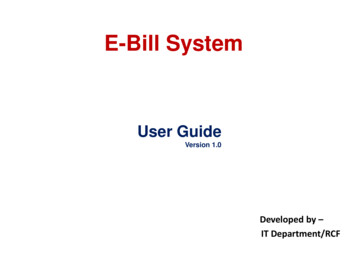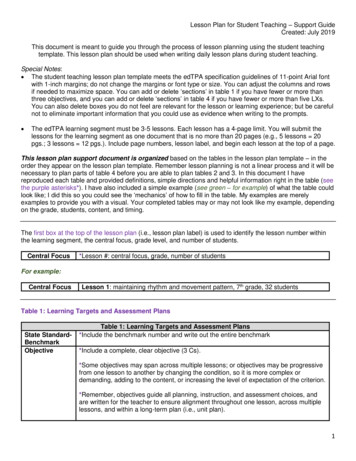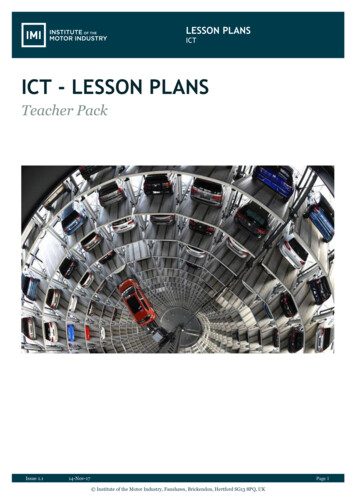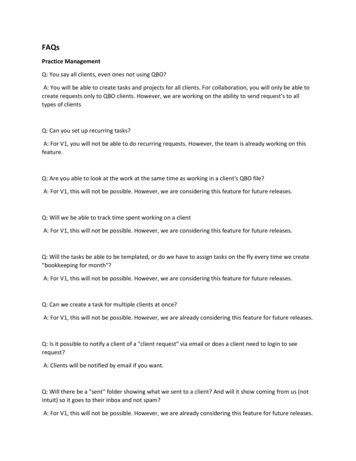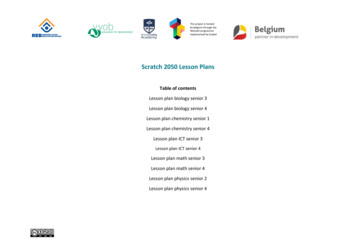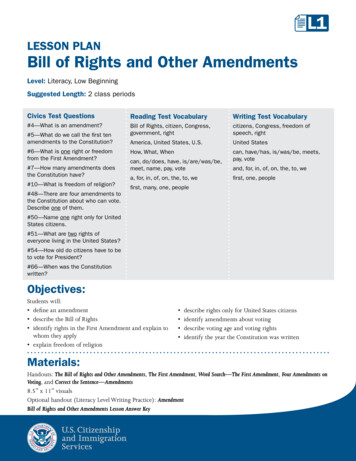
Transcription
L1LESSON PLANBill of Rights and Other AmendmentsLevel: Literacy, Low BeginningSuggested Length: 2 class periodsCivics Test QuestionsReading Test VocabularyWriting Test Vocabulary#4—What is an amendment?Bill of Rights, citizen, Congress,government, rightcitizens, Congress, freedom ofspeech, rightAmerica, United States, U.S.United StatesHow, What, Whencan, have/has, is/was/be, meets,pay, vote#5—What do we call the first tenamendments to the Constitution?#6—What is one right or freedomfrom the First Amendment?#7—How many amendments doesthe Constitution have?#10—What is freedom of religion?#48—There are four amendments tothe Constitution about who can vote.Describe one of them.can, do/does, have, is/are/was/be,meet, name, pay, votea, for, in, of, on, the, to, weand, for, in, of, on, the, to, wefirst, one, peoplefirst, many, one, people#50—Name one right only for UnitedStates citizens.#51—What are two rights ofeveryone living in the United States?#54—How old do citizens have to beto vote for President?#66—When was the Constitutionwritten?Objectives:Students will: define an amendment describe the Bill of Rights identify rights in the First Amendment and explain towhom they apply explain freedom of religion describe rights only for United States citizensidentify amendments about votingdescribe voting age and voting rightsidentify the year the Constitution was writtenMaterials:Handouts: The Bill of Rights and Other Amendments, The First Amendment, Word Search—The First Amendment, Four Amendments onVoting, and Correct the Sentence—Amendments8.5” x 11” visualsOptional handout (Literacy Level Writing Practice): AmendmentBill of Rights and Other Amendments Lesson Answer KeyBill of Rights and Other Amendments H www.uscis.gov/citizenship1
Lesson Overview and Notes to Teacher:This lesson explains the concept of amendments andthe background of the Bill of Rights in relation to theConstitution. We recommend teaching the lesson onBenjamin Franklin and the U.S. Constitution prior to thisone. This lesson covers details about the First Amendmentand voting rights. There are numerous pictures in thehandouts to help illustrate these concepts. We havealso included several 8 ½” x 11” visuals to use for classdiscussion. There are two activities, a word search andsentence correction, to help reinforce the new vocabularyand concepts. The Literacy Level Writing Practice handoutAmendment gives handwriting practice and reinforces aCivics Test item.Introduction: Write Constitution on the board. Ask thestudents What does the Constitution do? (defines thegovernment, protects basic rights). Explain that a rightmeans something you can do because it is allowed by law.Explain to the class that the Founding Fathers wanted tomake sure that the rights of individuals were protectedin the Constitution, which is why the Bill of Rights waswritten.Guided Practice: Distribute the handout The Bill of Rightsand Other Amendments. Read each sentence 2-3 times outloud for students to hear. Have the students repeat eachline after you. Explain any new vocabulary and have thestudents fill in short definitions in the New Words box(rights something you can do because it is allowed bylaw, amendment change to the Constitution, Bill ofRights first ten amendments, individual each person).Point out that When was the Constitution written?,What is an amendment?, What do we call the firstten amendments to the Constitution?, and How manyamendments does the Constitution have? are items onthe Civics Test.Practice: Distribute the handout The First Amendment.Discuss the photos in the handout, asking the studentswhat they see. Review the paragraph in the same manneras above. After you review the rights listed in the boxabout the First Amendment, have the students look at thepicture again and see if they can identify ways people inthe photo are exercising those rights (making a speech,reporters with microphones, people assembling, etc.)Discuss with the students whether citizens in their nativecountries have the same rights as in the First Amendment.You can also use the 8 ½” x 11” visuals for further classdiscussion or small group work. Point out that What isfreedom of religion?, What is one right or freedomfrom the First Amendment?, and What are two rightsof everyone living in the United States? are items on theCivics Test.Distribute the handout Word Search—The First Amendment.Review the vocabulary in the Word Bank and have thestudents find and circle the words in the puzzle.Evaluation: Distribute Correct the Sentence—Amendments.Have the students read each sentence and find the error.They should cross out the incorrect word or phrase andre-write the sentence correctly on the line below. Go overthe first sentence together on the board.Writing Practice for Literacy/Low BeginningStudents: The handout Amendment is included foroptional copy work. Point out that What is an amendment?is an item on the test.Distribute the handout Four Amendments on Voting andreview the sentences as previously described. Ask thestudents if they have ever voted in their native country.Discuss the voting laws in their countries, such as whois allowed to vote, voting age, voting tax, penalty for notvoting, and so on. Compare voting in other countries tothe U.S. voting amendments covered in this handout.Review these Civics Test items with the class: How olddo citizens have to be to vote for President?, Name oneright only for United States citizens, and There are fouramendments to the Constitution about who can vote.Describe one of them.2 Bill of Rights and Other Amendments H www.uscis.gov/citizenship
Attorney General Robert F. Kennedy speaking at a racial equality demonstration outside the Justice Department on June 14, 1963.Courtesy of the Library of Congress, LC-DIG-ppmsca-04295.
A newspaper stand in 1941.Courtesy of the Library of Congress, LC-USF346-BN-001359-Q-C.
A synagogue on Yom Kippur, circa 1900.Courtesy of the Library of Congress, LC-DIG-ggbain-02316.
Courtesy of the Library of Congress, LC-USZ62-123745.Striking textile workers participate in a Labor Day parade in Gastonia, North Carolina, 1934.
Courtesy of the Library of Congress, LC-USZ62-53202Until 1920, women were not allowed to vote in political elections. This image shows women petitioning for the right to vote (ca. 1917) in New York State.
The Bill of Rights and Other Amendments, The First Amendment, Word Search—The First Amendment, Four Amendments on Voting, and . Correct the Sentence—Amendments. 8.5" x 11" visuals Optional handout (Literacy Level Writing Practice): Amendment Bill of Rights and Other Amendments Lesson Answer Key. L1

